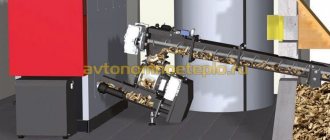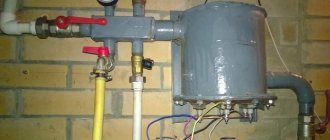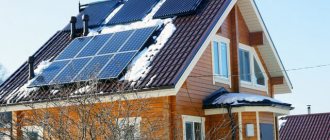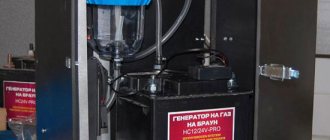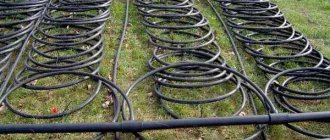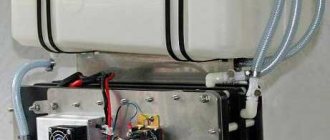Solar collectors: subtleties of application
To understand the principle of operation of solar collectors, remember an outdoor shower - install a metal tank of water above the shower stall and position it in such a way that it is exposed to direct sunlight for the maximum amount of time. Use heated water for bathing.
Solar collectors are a modern variation of a summer shower. The devices are a system of pipes through which water circulates. To better heat the liquid, the pipes are painted black, because it attracts the sun's rays.
The operation of the system is based on the ability of water to circulate when heated. To do this, the heat exchanger tank must be installed above the collector pipes. When heated, the water rises to the top of the heat exchanger. The cold liquid sinks to the lower part, where it is heated by the sun's rays.
This principle of operation allows you to do without additional equipment, making the operation of the system more economical without loss of performance. And let us immediately note that you can design it yourself. But it is better to give preference to industrial equipment, which will work better, providing the house with hot water all year round. The price of the issue in this situation is higher, but it fully pays off during the operation of the system.
In practice, solar collectors are often used by sanatoriums, hotels, and recreation centers, which have an influx of visitors during the warm season. They are also found in private households, where the owners use a different method of heating and water heating in winter.
Heat pump
To obtain energy from the depths of the earth, you will need to build a fairly complex device that will allow you to obtain alternative energy from groundwater, the soil itself, or from the air. Most often, such devices are used for heating rooms. In essence, the unit is a large refrigeration chamber, which, when cooling the environment, converts energy and releases it in the form of heat with high potential. System components:
- External and internal circuit with freon.
- Evaporator.
- Compressor.
- Capacitor.
Heat pump operation diagram
The collector can be installed vertically if the area of the site does not allow for horizontal installation. They drill several deep wells and lower the circuit into them. It is placed horizontally in the ground to a depth of one and a half meters. If the house is located on the shore of a reservoir, the heat exchanger is laid in the water. The compressor can be taken from the air conditioner. The condenser is made from a 120 liter tank. A copper coil is inserted into the container, freon will circulate through it, and the water from the heating system will begin to warm up.
The evaporator is made from a plastic barrel with a volume of more than 130 liters. Another coil is inserted into this tank; its combination with the previous one will be carried out through a compressor. The evaporator pipe is made from a piece of sewer pipe. The flow of water from the reservoir is regulated through the pipe.
The evaporator is lowered into the reservoir. Water flowing around it causes freon to evaporate. The gas rises into the condenser and gives off heat to the water that surrounds the coil. The coolant circulates in the heating system, warming the room.
Advice. The temperature of the water in the reservoir does not matter, only its constant presence is important.
Types of alternative electricity
The consumer is always faced with a choice based on the question, which is better? And in this regard, it is implied, firstly, the costs of purchasing a new type of source of electricity, and secondly, how long this device will work. That is, will it be profitable, will the whole undertaking pay off, and if it does, then after what period of time? Let's just say that no one has yet canceled saving money.
As you can see, there are plenty of questions and problems here too, because doing electricity yourself is not only a serious matter, but also quite expensive.
Electric generator
Let's start with this installation, as the simplest one. Its simplicity lies in the fact that you need to purchase an electric generator and install it in a secure, enclosed room that will comply with fire safety rules. Next, connect the electrical network of a private house to it, fill in liquid fuel (gasoline or diesel fuel) and turn it on. After which electricity appears in your home, which depends only on the availability of fuel in the generator tank. If you think through an automatic fuel supply system, then you get a small thermal power plant that will require minimal presence from you.
In addition, electric generators are reliable and convenient installations that work almost forever if used correctly. But there is one point. There are currently two types of generators on the market:
Which is better? Let's just say that if you need an alternative source of energy that will be used constantly, then choose diesel. If for temporary use, then gasoline. And that is not all. A diesel electric generator has large overall dimensions, compared to a gasoline one, it makes a lot of noise during operation and emits a huge amount of smoke and exhaust gases. Plus, it's more expensive.
Gas generators have recently appeared on the market that can run on both natural gas and liquefied gas. A good option, environmentally friendly, and does not require a special room for installation. You can connect, for example, several gas cylinders to one generator at once, which will be automatically connected to the installation.
Alternative to hydrocarbon fuels
Among the three types of electric generators, gas is the best and most efficient. But the cost of fuel (liquid or gaseous) is not cheap, so it’s worth thinking about producing your own fuel, investing a minimum of money in it. For example, biogas, which can be obtained from biomass.
By the way, alternative types of energy, which today are called biological, can replace almost all alternative sources of electricity. Eg:
- Biogas is produced by fermenting manure, bird droppings, agricultural waste, and so on. The main thing is to install equipment that is used to capture methane.
- From garbage, for example, in landfills, the so-called cellulose standard is extracted. Or, as experts call it, landfill gas.
Attention! Scientists have already calculated that if you recycle all the world's landfills, you can get up to 84 billion liters of landfill fuel, which can be used to generate electricity. IBGU-1 - installation for biogas production
IBGU-1 - installation for biogas production
- Soybean and rapeseed, or more precisely, their seeds, produce fats from which biodiesel can be obtained.
- A biostandard (biogasoline) can be produced from beets, sugar cane, and corn.
- Scientists have proven that using ordinary algae you can accumulate solar energy.
That is, there is a large number of scientific developments that produce alternative types of energy. And many of them have already received practical application. For example, the IBGU-1 installation, with the help of which up to twelve cubic meters of biogas can be obtained from manure per day. Domestic farmers appreciated the work of scientists, so this equipment is sold out quickly.
Types of alternative heating sources
In order to equip alternative heating for a private home with your own hands, there are several options that will help you save a considerable amount of money while consuming absolutely renewable energy.
1. Biofuel. This option is completely environmentally friendly due to the use of special briquettes and pellets, which include manure, plants, wastewater and other natural waste. By the way, such fertilizer can be obtained at home.
A boiler is used as a converting device; fuel is supplied automatically. To switch from gas heating to biofuel heating, there is no point in changing the entire heating system: just replace the boiler and connect it to the system.
To independently organize an effective biofuel heating system, you can also build a fireplace, which, if all installation rules are followed, is quite capable of efficiently warming up a small private house.
2. Solar energy. Converting solar energy into thermal energy is a modern and fairly economical way to heat a room. This type of heating is practically free: all you need to do is buy a solar collector or assemble it yourself from components that can easily be found in specialized stores. Installing the collector is quite simple, so you can do it yourself. The collector is installed on the roof, where the device will collect solar energy and transfer it to a mini-boiler room located inside the house. Modern solar collectors are effective even in cloudy weather.
This heating option for a private home will allow you to heat your home for free even in severe frosts. Moreover, if you installed the collector correctly and connected it to internal communications, you can use solar energy to heat water for domestic needs.
3. Energy of earth and water. To set up such a heating system, you will need to install a heat pump, which requires electricity to operate. In this case, you can save 10-20% of cash costs compared to gas heating. You can also install a heat pump yourself, especially since compared to gas equipment, it is absolutely safe.
Heat pumps can operate in 2 types: - water-water; - brine-water.
For the first type, it will be necessary to drill 2 wells for lifting and 2 for draining water, about 50 m deep. All this work can be carried out on your own, but with the permission of government agencies.
For the second type, you will need a well with a depth of at least 200 m. Pipes with a solution must be laid in the well. To reduce the difference in output heat at different times of the year, you can install a heat exchanger.
Despite the relative complexity of installation, such a heating system will allow you to receive almost free heat, the main thing is to make the correct calculations and take into account all the nuances.
4. Infrared heating and “warm floor” system. Heating using infrared heat sources can be easily arranged independently. To do this, you just need to buy infrared heaters and place them in the house. Their cost is relatively inexpensive, and such devices can become an effective element of home decor.
A heated floor system can also be installed on your own in just a couple of days. To do this, you will need infrared film, which must be laid immediately under the top layer of the floor covering. This process does not require any special skills; you just need to remove the existing coating, lay down a film and put on a new coating.
This alternative heating for a private home is quite simple to install and allows you to effectively heat the room.
Renewable Energy Sources
Wind generators on the roof of a private house
Due to the limited availability of fossil fuels, scientists around the world are developing and putting into operation energy sources of the future. Renewable ones include:
- Electricity generators - in Russia, electric, gasoline and gas are most often used. The latter runs on liquefied and natural fuels, due to its low noise level it is used in everyday life and is durable.
- Solar energy - a person uses electromagnetic radiation. The source of electricity and autonomous heating is silent and environmentally friendly.
- Wind turbines operate on the basis of the transformation of the kinetic energy of the wind into the mechanical rotation of a turbine that produces alternating current. Horizontal and vertical wind turbines are characterized by high efficiency.
- Biofuels - the best options would be oilseed fats, algae, gas from the fermentation of organic waste.
- Stations with a water wheel are a convenient source of energy if there is a river near the house. The turbine wheel is driven by water flows.
- Geothermal solutions – in seismically active areas, they convert the heat generated when geothermal water is released.
Russia has several solar stations - in the Orenburg region (capacity 40 MW), in the Republic of Bashkortostan (capacity 15 MW), in the Crimea (10 units, 20 MW each).
Option 4 installation for biogas production
During anaerobic processing of organic waste, so-called biogas is released. The result is a mixture of gases consisting of methane, carbon dioxide and hydrogen sulfide. The generator for producing biogas consists of:
- sealed tank;
- auger for mixing organic waste;
- pipe for unloading the waste mass;
- necks for filling waste and water;
- pipe through which the resulting gas flows.
Often, a container for waste recycling is installed not on the surface, but in the thickness of the soil. To prevent leakage of the resulting gas, it is made completely sealed. It should be remembered that during the process of biogas release, the pressure in the tank constantly increases, so the gas must be taken out of the tank regularly. In addition to biogas, the processing results in an excellent organic fertilizer useful for growing plants.
The design and operating rules of such a gas generator are subject to increased safety requirements, since biogas is dangerous to inhale and can explode. However, in a number of countries around the world, for example, in China, this method of generating energy is quite widespread.
The design of the generator for producing biogas is very simple, but some caution should be exercised when operating it, since biogas is a flammable substance hazardous to health
The composition and amount of biogas obtained from waste depends on the substrate. The most gas is obtained by using fat, grain, technical glycerin, fresh grass, silage, etc. Typically, a mixture of animal and vegetable waste is loaded into the tank, to which a certain amount of water is added. In summer, it is recommended to increase the humidity of the mass to 94-96%, and in winter, 88-90% moisture is sufficient. The water supplied to the waste tank should be heated to 35-40 degrees, otherwise the decomposition processes will be slowed down. To retain heat, a layer of thermal insulation material is mounted on the outside of the tank.
It always seemed to me that alternative energy was too expensive in terms of investment, but you were able to convince me. On the one hand, it is difficult to assemble the necessary devices manually (I haven’t tried it personally, so I can’t judge). On the other hand, if everything can be done correctly, the alternative energy source will pay for itself in any case. Nowadays electricity costs a lot of money. But I think that alternative energy can only be installed in a private house, because... In the city, the supervisory services (I don’t remember the name) will not look at this very approvingly - perhaps they will even fine you. I live in the city and there is no opportunity to try such things.
If you combine all types of alternative energy production, then perhaps this will significantly reduce energy costs and even pay for your construction someday. Judging by the article, assembling an alternative energy source is not that difficult, but it still requires some skills. If you consider installing solar panels on the roof, and in addition to them a wind installation, you can get an almost universal source of energy in any weather. And if you add biogas, then it will be absolutely beautiful. However, all these methods are good only for the warm season (well, or autumn, when there is a strong wind), but in winter the sun is not often, and neither is the wind. How to be in this case?
Features of installation and operation of autonomous sources
In order to install an alternative source of electrical energy on your country plot, cottage or apartment, you do not need to obtain any permits or approvals. It is the right of each user to determine for himself how to provide himself and his loved ones with electricity.
However, when constructing devices with high power, it is necessary to take into account factors affecting the environment and nearby neighbors.
So when using:
- Solar energy - when placing a large number of solar panels, significant areas will be required, and therefore, it may be necessary to draw up documents for additional land plots.
- Wind energy - it is necessary to take into account that wind generators, during operation, emit noise, which can negatively affect others.
- Water energy - in the case of a dam, a certain amount of land is taken out of service, which must be taken into account during construction.
- Biofuels - when producing the gaseous form of this energy source, smell is a constant component of the production process. This must be taken into account when creating this method of producing electrical energy.
In addition to the fact that there are no prohibitions on the installation of equipment producing electrical energy using alternative sources, there is also a law according to which every citizen who has installed equipment with a power of up to 30.0 kW, and receives excess electrical energy that he himself does not can use - has the right to sell it to third-party consumers. This right is called the “Green Tariff”.
Heating a house with solar heat storage collectors
Alternative heating using solar heat storage panels will directly depend on the intensity of the sun's rays, which varies at different times of the year. At night and in cloudy weather, there is not enough solar radiation to operate the collectors.
What is it used for?
Solar panels are often used to heat water or for domestic and household needs. Hot water takes part in heat exchange in monovalent storage tanks. Solar panels can act as an additional source of thermal energy generation for water heating and heating systems in biovalent storage tanks.
Types of solar collectors
Solar collectors are divided into two types:
If the equipment is used in the summer, the performance coefficient of both types will be the same. For winter it is recommended to use vacuum manifolds. They can operate at temperatures down to -35 degrees.
Flat-plate collectors are capable of heating air up to +60 degrees. Vacuum collectors are designed for heating up to +90. In other parameters the devices are similar.
Collectors with vacuum pipes are excellently used as alternative heating for a country house. At the same time, the devices can heat water.
https://youtube.com/watch?v=-oExo23Bhf4
A hydrodynamic water heating system is another good alternative to gas heating. It is not yet very famous, but its simplicity and advantageous use for heating a home makes it noticeable. In addition to water, the installations allow heating oil, salty and dirty water.
Self-production of solar panels
Solar installations are an alternative to traditional electricity, which in finished form is expensive. If you assemble it yourself, you can reduce the cost of the structure by 3-4 times. Before you start creating a solar panel, you need to understand the principle of its functionality.
How does a solar power system work?
To imagine the principle of operation, it is worth starting with the design. The design of solar energy sources includes:
- solar panel - a complex of units for converting sunlight into an electron flow;
- Batteries – there are several of them in the system, the number depends on the power of the consumers;
- charge controller – ensures normal charging of the battery without overcharging;
- inverter - transforms low voltage current from batteries into high voltage current (3-5 kW is enough for a home).
The solar panels individually produce low voltage currents (about 18-21 V), which is enough to charge a 12 volt battery.
Creation of a solar battery
Materials for the manufacture of a solar panel
The battery is assembled from modular photocells. One household module contains 30, 36 and 72 elements. They are connected in series to a power source whose maximum voltage is 50 V.
For the body part you will need wooden beams, fiberboard, plexiglass and plywood. The bottom of the box is cut out of plywood and inserted into a frame made of 25 mm thick bars. Holes are made around the perimeter of the frame. To prevent overheating of the elements, the drilling step should be 15-20 cm.
Solar panel assembly
A fiberboard backing with ventilation holes is cut out of the fiberboard using a utility knife. They are made according to a square-nested pattern with an indentation of 5 cm. Then:
- The elements are laid with their upper part on the substrate and soldered.
- Connections are made sequentially, in order.
- The finished rows are connected to busbars that conduct current.
- The elements are turned over and secured in place with silicone.
- Check the output voltage parameters. Its range is from 18 to 20 V.
- The battery is run in for 2-3 days to test the charging ability.
- At the end of the inspection, the joints are sealed.
Preparing the panel for installation
Paint and dry the substrate 2 times.
After checking the functionality, the solar panel is assembled:
- The input and output contacts are brought out.
- Cut out the plexiglass cover and fix it with self-tapping screws to the pre-drilled holes.
- When using a diode circuit of 36 diodes with a voltage of 12 V, remove the paint from the part with acetone.
- Holes are made in the plastic panel, diodes are inserted and soldered.
The final step is installation and orientation of the solar panel to facilitate maintenance access and energy efficiency.
Rules for installing a solar panel
Connecting a solar panel
Industrial modifications can rotate independently. Household devices must be set according to several parameters:
- Moving away from shaded areas - a tree or a tall building nearby will make the device ineffective.
- Orientation to the sunny side. Residents of the northern hemisphere orient the structure to the south, while residents of the southern hemisphere orient it to the north.
- The angle of inclination is tied to the geographical latitude of the site. In summer, it is better to tilt the solar panel 30 degrees to the horizon, in winter – 70 degrees.
- Availability of access for maintenance - removal of dust, dirt, and accumulated snow.
Wind generators
This is the second possible option. However, it is advisable to consider such structures as an alternative only if the average annual wind speed in the area is at least 6-8 m/s. The installation of wind turbines is justified on plains and hills. Maximum efficiency of the equipment can be expected if the house is located near a wide river or other large bodies of water.
Types of wind generators
These simple blade structures, known to mankind for a very long time, have changed somewhat in our time. Now wind generators are classified according to several main parameters.
- Axle placement. It can be horizontal or vertical. The first devices make it possible to rotate the main part in search of wind. The latter are good because the main equipment is located below, on the ground, which simplifies maintenance. But their efficiency is lower.
- Number of blades. There may be two, three or more. The choice of design depends on the wind conditions in the region. Multi-blade devices are advisable to use at low wind speeds, but they are not so popular due to the need to install a gearbox.
- Material for making blades. They can be sailed or rigid. The best, logical choice is the second, most durable wind generators, since unreliable sailing material will require frequent replacement due to damage.
- Screw pitch. It can be fixed or changeable. The latter gives a chance to increase the number of operating speeds. The disadvantage of designs with variable pitch is the complexity of the devices and their large mass.
The power of wind generators depends on the blades and their area.
Wind turbine elements
Any model of wind turbines has:
- blades, the rotation of which ensures the movement of the rotor;
- generator producing alternating current;
- an inverter that converts direct current into alternating current;
- controller that controls the blades, responsible for transforming alternating current into direct current;
- rechargeable batteries that accumulate and equalize electricity.
The last important element is the mast, which is necessary to give the blades the opportunity to successfully “catch” the wind.
Wind generator from a self-generator
This is the easiest way to create an energy source with your own hands. Such a design can be standalone, or become part of a system consisting of several types of traditional and/or alternative equipment. In addition to the car generator, the technician will need a battery. The remaining elements can be easily made from materials that are often found in every home.
wind wheel
Blades are made from various materials. They can be turned into wood, thick fabric, plastic or metal. The most malleable and practical candidate is plastic, so it makes sense to consider making a windwheel from plastic sewer pipe. Its minimum thickness is 40 mm. In this case, the work includes several simple steps.
- First, the dimensions of the parts are calculated. An important parameter for a pipe is its diameter. It should be 1/5 of the length of the future blades.
- The pipe is cut lengthwise into 4 equal parts. This operation is done with a jigsaw. Having cut out the first piece, it is used as a template for the rest.
- The edges of all elements are cleaned with sandpaper. They are then attached to an aluminum disk. An auto-generator is also screwed to it.
The number of blades matters. For example, in order to reduce the load on each element, it is recommended to make them larger, but each should be smaller. The last required operation is balancing the wind wheel. It is brought into the room and fixed horizontally on a tripod. If the structure remains motionless, then the job is done correctly. Otherwise, it will need to be balanced.
Mast
It is made from steel pipe. The diameter is 150-200 mm, the length of the support is at least 7 m. If there is any high obstacle on the site, it is recommended to raise the wind wheel so that it rises at least a meter above the obstacle. Galvanized or steel cables are used as guy wires. Its thickness is 6-8 mm. The mast and pegs intended for fixing the guy wires are concreted.
Transformation of a self-generator
Re-equipment of a car generator consists of two stages: rewinding the stator wire and manufacturing a rotor equipped with neodymium magnets.
- When rewinding a coil, it is necessary to take into account that the efficiency of the future equipment depends on the number of turns.
- To fix the magnets in the poles of the rotor, holes for them are drilled in the device. All voids between the magnets are covered with epoxy resin, then the rotor is wrapped in paper.
After completion of work, the device is tested. The ideal at 300 rpm would be 30 V.
Completion of assembly
The rotating axis of the wind generator is made of a pipe and two bearings that are mounted on it. The tail part is made of galvanized iron, its thickness is 1.2 mm. A profile pipe is used as a frame to fix the windmill on the mast. In this case, it is necessary to ensure a safe distance between the blades and the mast. The minimum value is 250 mm.
Waste into income: biogas plants
All alternative energy sources are of natural origin, but double benefits can only be obtained from biogas plants. They process waste from domestic animals and poultry. The result is a certain volume of gas, which, after purification and drying, can be used for its intended purpose. The remaining processed waste can be sold or used on fields to increase yields - a very effective and safe fertilizer is obtained.
Energy can also be obtained from manure, but not in pure form, but in the form of gas
Briefly about technology
Gas formation occurs during fermentation, and bacteria living in manure are involved in this. The waste of any livestock and poultry is suitable for producing biogas, but cattle manure is optimal. It is even added to the rest of the waste for “ferment” - it contains exactly the bacteria needed for processing.
To create optimal conditions, an anaerobic environment is necessary - fermentation must take place without oxygen. Therefore, effective bioreactors are closed containers. To make the process more active, regular mixing of the mass is necessary. In industrial installations, mixers with electric drives are installed for this purpose; in home-made biogas plants, these are usually mechanical devices - from the simplest stick to mechanical mixers that “work” by hand force.
Schematic diagram of biogas plants
Two types of bacteria are involved in the formation of gas from manure: mesophilic and thermophilic. Mesophilic are active at temperatures from +30°C to +40°C, thermophilic - at +42°C to +53°C. Thermophilic bacteria work more efficiently. Under ideal conditions, gas production from 1 liter of usable area can reach 4-4.5 liters of gas. But maintaining a temperature of 50°C in the installation is very difficult and expensive, although the costs are justified.
A little about designs
The simplest biogas plant is a barrel with a lid and a stirrer. The lid has a terminal for connecting a hose through which gas enters the tank. You won’t get a lot of gas from such a volume, but it’s enough for one or two gas burners.
More serious volumes can be obtained from an underground or above-ground bunker. If we are talking about an underground bunker, then it is made of reinforced concrete. The walls are separated from the ground by a layer of thermal insulation; the container itself can be divided into several compartments in which processing will take place with a time shift. Since mesophilic cultures usually work under such conditions, the entire process takes from 12 to 30 days (thermophilic cultures are processed in 3 days), therefore a time shift is desirable.
Scheme of a bunker biogas plant
Manure enters through the loading hopper; an unloading hatch is made on the opposite side, from where processed raw materials are taken. The bunker is not completely filled with the bio-mixture - about 15-20% of the space remains free - gas accumulates here. To drain it, a tube is built into the lid, the second end of which is lowered into a water seal - a container partially filled with water. In this way, the gas is dried - already purified gas is collected in the upper part, it is removed using another tube and can already be choked to the consumer.
Everyone can use alternative energy sources. It is more difficult for apartment owners to implement this, but in a private house they can at least implement all the ideas. There are even real examples of this. People fully provide for their own needs and for their large households.
What is an alternative heat source
Since traditionally the house is heated with a gas boiler, by alternative home heating we mean any heating device that does not run on gas.
When is it relevant?
- You are unable to connect to the gas network or it is too expensive;
- You want to reduce your dependence on gas and have insurance in case of severe frosts or interruptions in its supply;
- To save on heating costs. Combining and properly managing heat sources will reduce your heating costs.
Types of Alternative Energy Sources
Conventionally, alternative heat sources are divided into two types:
- Which work in addition to the boiler. For various reasons, they are not able to fully provide the building with heat. The main heating power is provided by the gas boiler, and other sources support its operation during peak loads or off-season.
- Which replace a gas boiler. These are the heat sources that are capable of producing sufficient heating power to warm the building.
Let's consider what devices can be used in each case.
